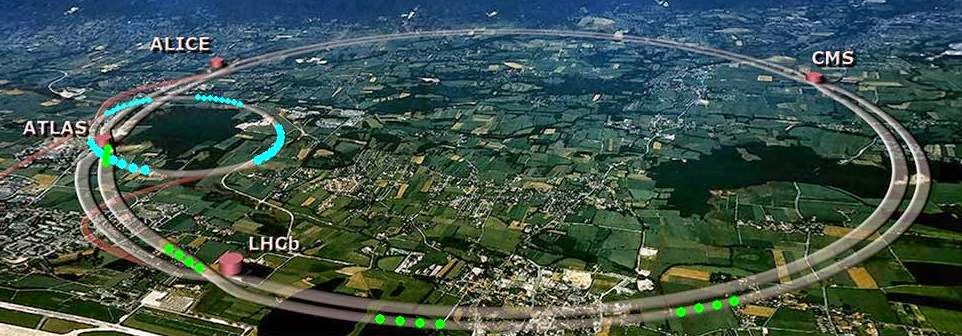The Large Hadron
Collider: The world's
largest atom smasher
Regarded as the crown jewel of
CERN, the Large Hadron Collider (LHC) is an
incredible piece of engineering that has allowed
physicists to study particle interactions in a
manner that cannot be matched by any other
particle physics facility in the world.
The LHC is the culmination of 24 years (with 20 of
those spent actually constructing the facility)
and 10 billion euros. It is capable of
accelerating and colliding particles at speeds far
greater than any other laboratory, thanks to the
way it was built. The collider consists of a
17-mile ring-shaped tunnel that houses several
thousand supercooled supermagnets that serve to
manipulate the two beams used in experiments.
a
The span of the LHC's tunnels,
including the location of four detectors.
There are seven detectors in place
along the LHC tunnel, each of which serves its own
project and team:
- A Large Ion Collider Experiement
(ALICE) - measures and analyzes lead-ion
collisions; studies quark-gluon plasma
- A Toroidal LHC Apparatus (ATLAS)
- a general purpose detector that helped to
discover and confirm the existence of the Higgs
boson
- The Compact Muon Solenoid (CMS)
- a similar function to ATLAS, but uses a
solenoid, "a cylindrical coil of superconducting
cable that generates a magnetic field of four
(teslas)"1
- The Large Hadron Collider beauty
(LHCb) experiment - specializes in the study of
the asymmetry observed between matter and its
antimatter counterparts by measuring the decay
of particles in the twin beams used in the LHC
- The Large Hadron Collider
forward (LHCf) experiment - measures the
particles resulting in proton-proton and
neutron-proton collsions, with the purpose of
estimating and understanding ultra high-energy
cosmic rays
- The TOTal Elastic and
diffractive cross section Measurement (TOTEM)
experiment - measuring the size of protons at
the LHC
- Monopole and Exotics Detector at
the LHC (MoEDAL) - using nuclear track detectors
to search for "hypothetical highly ionising
particles such as magnetic monopoles"2
a
A photograph of the CMS detector.
While the LHC is truly a feat of
modern engineering, it has not been without its
complications. In September of 2008, the first
protons were sent around the accelerator, but the
LHC had to be shut down for repairs only 12 days
later after an incident resulted in the damaging
of 50 supermagents, which prompted a two year
shutdown for repairs. In addition, due to its
location in the Swiss countryside, the LHC has
experiences numerous incidents with wildlife
interfering with the facility: in April 2016, a
weasel damaged several connections before being
electrocuted by a 66,000-volt transformer, causing
a week-long closure. In November of the same year,
another weasel crossed a substation fence and was
subsequently shocked by an 18,000-volt
transformer, resulting in another shutdown. In
2009, a piece of a baguette, believed to be a
bird's breakfast, was caught in some electric
equipment, causing a short that shut down the
facility for a period of time.
The LHC has been shut down since December of 2018
for upgrades, and is scheduled to continue
smashing atoms in 2021.
»»——⍟——««
1, 2 - LHC
FAQ: The Guide.